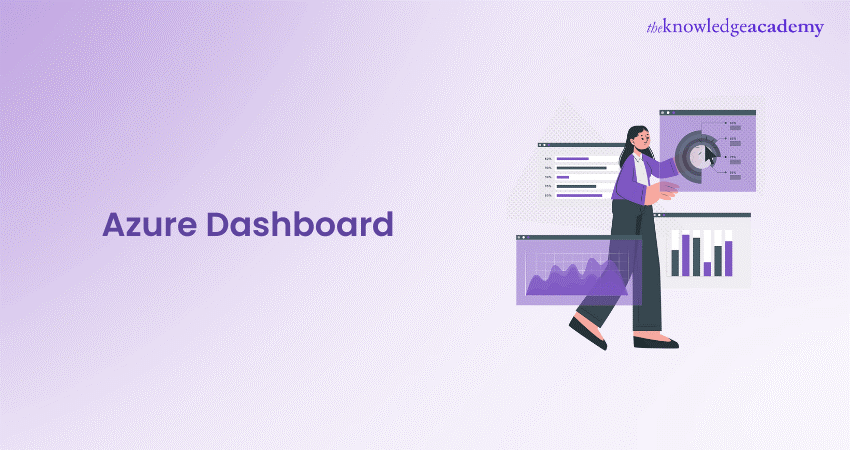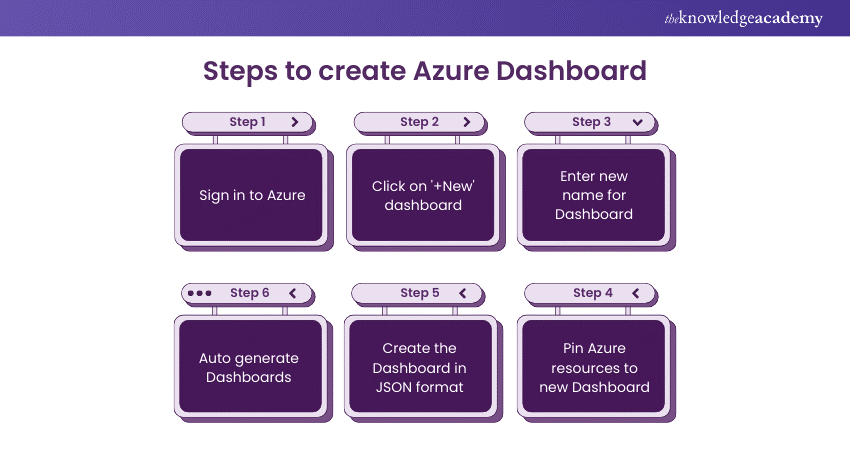We may not have the course you’re looking for. If you enquire or give us a call on + 1-866 272 8822 and speak to our training experts, we may still be able to help with your training requirements.
We ensure quality, budget-alignment, and timely delivery by our expert instructors.
- Retired : Designing and Implementing Enterprise-Scale Analytics Solutions Using Microsoft Azure and Microsoft Power BI DP500
- Microsoft Azure Administrator AZ104
- Data Engineering On Microsoft Azure DP-203 Certification
- Microsoft Azure Security Technologies AZ500
- Designing And Implementing Microsoft DevOps Solutions AZ400

Looking for a top-notch control room for your cloud services? Step into the Azure Dashboard, Microsoft Azure’s go-to solution for easy cloud management. This vibrant platform revolutionises how you manage your Azure services, with a user-friendly interface that lets you monitor and control everything in real-time.
The Azure Dashboard is your essential partner in the cloud-first world. It’s more than just a tool; it’s your command centre, giving you a comprehensive view of your digital realm. Explore the Azure Dashboard, where every detail and resource are within reach, leading to smarter and more efficient cloud operations. Want to know more? Keep reading this blog!
Table of Contents
1) What is Azure Dashboard?
2) Steps to creating an Azure Dashboard
3) Features of Microsoft Azure Dashboards
4) Benefits of the Azure Dashboard
5) Conclusion
What is Azure Dashboard?
The Microsoft Azure Dashboard is a robust platform offering a unified and customisable interface for managing and monitoring Azure resources. It acts as a command centre, allowing users to consolidate data and insights from various Azure services and subscriptions, providing a holistic view of their cloud ecosystem. For more information on how this integrates with your overall cloud strategy, explore the Microsoft Azure offerings and features.
A standout feature of the Azure Dashboard is its adaptability and customisation capabilities. Users can design dashboards that align with their unique requirements and preferences. They can instantly incorporate and organise widgets like charts, graphs, metrics, and resource tiles to visualise critical data and metrics.
Moreover, these widgets can be set up to show real-time data, keeping users updated on the status, performance, and utilisation of their Azure resources. Notably, the Azure Dashboard facilitates multi-dashboard functionality, enabling users to craft multiple dashboards for diverse purposes or scenarios. For advanced data integration and orchestration that can enhance your dashboards, consider integrating Azure Data Factory to streamline and manage data workflows effectively.
Users can effortlessly toggle between dashboards to concentrate on their Azure environment's facets or tackle different tasks or goals. This smooth process promotes seamless transitions, allowing users to rapidly access and view varying resources, metrics, and insights customised to their specific needs and preferences.
Steps to creating an Azure Dashboard
You can create a new private dashboard in Azure by following these steps:

a) Sign in to the Azure portal, and from the menu, select Dashboard.
b) Click on the ‘+New’ dashboard tab at the top.
c) In the ‘Tile’ gallery, select tiles you can arrange on an empty grid.
d) To change the dashboard's name, click ‘My Dashboard’ and enter the desired name.
e) Once you're done customising, click on Done customising in the page header.
f) The dashboard view will now display your newly created dashboard.
Additionally, Azure offers various methods to create and customise dashboards. This is how you can do it:
a) Utilise the dashboard editor.
b) Pin Azure resources to your dashboard.
c) Create a dashboard in JSON format that represents it programmatically.
d) Auto-generate dashboards for quick setup.
Whether through the Graphical User Interface (GUI) or JSON, users have flexibility in creating and managing their Azure Dashboards to effectively suit their monitoring and management needs.
Features of Microsoft Azure Dashboards
Azure Dashboards offer an array of functionalities that help you effectively monitor and manage your Azure resources and services. These include:
Tailored Dashboards
Azure Dashboards are highly adaptable, enabling you to construct custom dashboards that showcase the metrics and data most pertinent to your needs. This allows for a personalised experience, ensuring that the most relevant information is always at your fingertips.
Live Data Updates
One of Azure Dashboards' key features is its ability to display real-time data. This means you can actively monitor the performance and status of your resources and services as events unfold, allowing for timely responses and adjustments as necessary.
Engaging and Interactive Widgets
Azure Dashboards come equipped with interactive widgets, such as charts and tables. These tools allow you to explore your data more deeply, providing more comprehensive insights into the performance and usage of your resources and services. This feature enhances your understanding and control over your Azure environment. To further automate and extend the capabilities of your dashboards, you can integrate Azure Functions to create serverless workflows and custom triggers based on your data insights.
Cross-Resource Data Queries
Azure Dashboards also support cross-resource queries. This powerful feature lets you pull data from multiple resources and services and display it in a single, unified dashboard. This holistic view can significantly enhance your understanding and management of your Azure ecosystem.
Integration with Azure
Azure Dashboards can be integrated with Azure Alerts. This allows you to set up alerts and notifications based on the data displayed in your dashboard. This proactive approach ensures you are always informed of significant events or changes in your Azure environment.
In addition to these features, Azure Dashboards support collaboration, allowing multiple users to view and interact with the same dashboard. This makes it a good tool for teams working together on complex projects. To further enhance your collaborative efforts and access a wide range of tools and solutions, explore the Azure Marketplace for additional resources and integrations.
Furthermore, Azure Dashboards are designed with a user-friendly interface, making it easy for beginners to navigate and utilise its features effectively. Overall, Azure Dashboards are a comprehensive tool for managing and monitoring your Azure resources and services.
Benefits of the Azure Dashboard
The many benefits of the Azure Dashboard comprise the following:
a) Microsoft Azure empowers users to craft personalised dashboards.
b) The Azure Dashboard becomes invaluable When managing multiple services in the Azure portal.
c) This feature is a compilation of shortcuts to Azure resources, simplifying access, organisation, and visualisation.
d) Azure Dashboard provides direct access to preferred resources tailored to individual preferences.
e) Crafting a custom dashboard facilitates swift consumption of pertinent data, aids in issue identification, and streamlines navigation.
Are you interested in gaining a competitive edge in the market? Then register now for our Microsoft Azure Training!
Conclusion
Azure Dashboard is a versatile tool for managing and monitoring Azure resources efficiently. Its customisable features and user-friendly interface simplify access to critical data, streamline organisation, and enhance decision-making processes within the Azure environment.
Ready for the Azure 900 exam? Download the Microsoft Azure 900 Study Guide today!
Frequently Asked Questions
What is the Limit on the Number of Private Dashboards a User in the Azure Portal can Create?

The limit on the number of private dashboards a user in the Azure portal can create is 100.
What is the use of a Dashboard in Azure?

Azure Dashboard is a customisable interface for managing and monitoring Azure resources. It aggregates data from various services, displays real-time information, and allows cross-resource queries.
What are the other resources and offers provided by The Knowledge Academy?

The Knowledge Academy takes global learning to new heights, offering over 3,000 online courses across 490+ locations in 190+ countries. This expansive reach ensures accessibility and convenience for learners worldwide.
Alongside our diverse Online Course Catalogue, encompassing 19 major categories, we go the extra mile by providing a plethora of free educational Online Resources like News updates, Blogs, videos, webinars, and interview questions. Tailoring learning experiences further, professionals can maximise value with customisable Course Bundles of TKA.
What is Knowledge Pass, and how does it work?

The Knowledge Academy’s Knowledge Pass, a prepaid voucher, adds another layer of flexibility, allowing course bookings over a 12-month period. Join us on a journey where education knows no bounds.
What are the related Azure courses and blogs provided by The Knowledge Academy?

The Knowledge Academy offers various Microsoft Azure Certifications, including the Microsoft Azure Fundamentals AZ-900 Certification Course, Microsoft Azure Security Technologies AZ500 Training, and Designing and Implementing Microsoft DevOps Solutions AZ400 Training. These courses cater to different skill levels, providing comprehensive insights into Azure Marketplace.
Our Cloud Computing Blogs cover a range of topics related to Azure, offering valuable resources, best practices, and industry insights. Whether you are a beginner or looking to advance your Cloud Computing skills, The Knowledge Academy's diverse courses and informative blogs have got you covered.
Upcoming Microsoft Technical Resources Batches & Dates
Date
 Microsoft Azure Fundamentals AZ-900 Certification
Microsoft Azure Fundamentals AZ-900 Certification
Fri 11th Apr 2025
Fri 13th Jun 2025
Fri 8th Aug 2025
Fri 26th Sep 2025
Fri 21st Nov 2025






 Top Rated Course
Top Rated Course



 If you wish to make any changes to your course, please
If you wish to make any changes to your course, please


